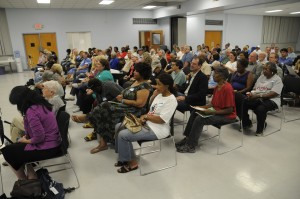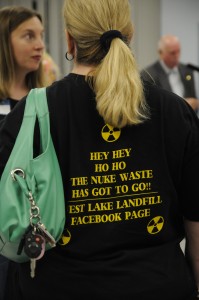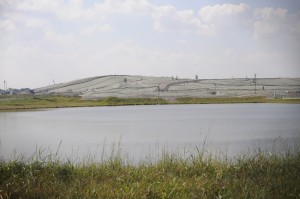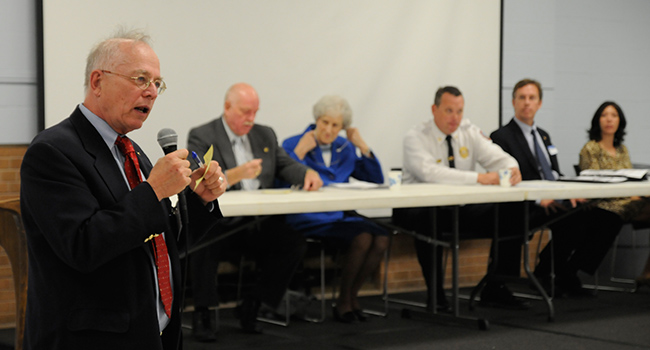UNIVERSITY CITY, Mo. — Rep. Rory Ellinger, D-University City, hosted a town hall meeting Thursday evening to discuss concerns from residents in his district and North St. Louis County about a fire underneath the Bridgeton Landfill and its potential to hit radioactive waste in the neighboring West Lake Landfill.
Last week, the landfill announced its plan to create a trench between the smoldering event, or underground fire, in the Bridgeton Landfill, and the West Lake Landfill, an Environmental Protective Agency (EPA) Superfund that contains nuclear waste.
“The isolation barrier will ensure that the subsurface smoldering event, located in the South Quarry at the Bridgeton Landfill, will never come into contact with the low-level, radiologically impacted material buried over 1,200 feet away in the neighboring West Lake Landfill,” according to the press release from Bridgeton Landfill, LLC.

The town hall discussion also strongly centered on the West Lake Landfill itself and contains dumped radioactive waste from The Manhattan Project — which has seeped into the Missouri River floodplain, according to the Missouri Coalition for the Environment. The town hall featured Rep. Bill Otto, D-Maryland Heights, long-time St. Louis environmental activist Kay Drey, Pattonville Fire Protection District Assistant Chief Matt LaVanchy, St. Louis County Director of Intergovernmental Affairs Thomas Curran and Bridgeton resident Dawn Chapman.
Chapman has spearheaded community activism and has utilized Facebook to help keep the public informed. The “West Lake Landfill” Facebook page has 2,626 members.
“We’ve come together as a community and decided that, to quote Erin Brockovich, Superman’s not coming,” Chapman said. “We have to take control of the situation and we have to fight so people have the correct information and they can make correct decisions to keep us safe.”
Chapman moved into the area about nine years ago and if she would’ve known she was moving near the Bridgeton Landfill and the West Lake Landfill, she said she never would have moved there. An odor in her neighborhood sparked her concern and she called the Missouri Department of Natural Resources (DNR). The DNR employee informed Chapman she lived near a landfill.
“At the end of the conversation, right when I thought it couldn’t get any worse, he says, ‘Yeah, you know about that fire but I have to tell you that you live next to something even worse,’” Chapman said.
That’s when Chapman was informed she also lived next to the West Lake Landfill.
Her state representative, Bill Otto, D-Bridgeton, has been aware of landfill concerns since the early 1990s when he was on the Bridgeton City Council, but he said an uprising of community awareness in January brought it further to his attention.
“The fact of the matter is that no matter what they do with this fire, no matter what they do with this landfill…radioactive waste is still sitting there,” Otto said. “I came out a couple of months ago and said it’s time to do something about that waste. Let’s get it out of there. It’s on the surface. You can drive by it. You can go swimming in it. It’s just improper the way it’s set.”
He said he is happy with the work Attorney General Chris Koster, the DNR and other state agencies have done so far and has a “high level of confidence” in the trench. LaVanchy also said he had “every confidence” the trench would prevent the fire from crossing over into West Lake despite not seeing an engineering plan.
 “A fire break is known to be scientifically effective if it’s wide enough and the correct material is used, then it’s effective,” LaVanchy said.
“A fire break is known to be scientifically effective if it’s wide enough and the correct material is used, then it’s effective,” LaVanchy said.
Kay Drey, an environmental activist in St. Louis for about 40 years, said her goal is not only to have the waste removed, but removed by the Army Corps of Engineers because she feels it is the only group that can safely handle the job. She said the Army Core of Engineers removed radioactive waste from other dumps sites on Latty Avenue in Hazelwood, Mo. The waste on Latty was left over from Mallinckrodt Chemical Works, the company that purified uranium to develop the atomic bomb.
“Unfortunately the brilliant scientists who brought us into the atomic age were never asked if they could get us out,” Drey said.
Curran said the St. Louis County Office has been in communication with Karl Brooks, regional administrator for the EPA Region seven, “to keep on this issue to the best of our ability.” He added that landfills are monitored by the county through the St. Louis County Department of Health, but governing radioactive waste is out of the county’s jurisdiction.
“We are very reliant in the federal government to provide us with assistance in this area,” Curran said.
Curran also stated that the St. Louis County Department of Health is researching contingency plans in case an emergency happened. Because landfill fire near radioactive waste is a “unique situation,” there was no plan in other states to review as a precedent.
As a result of the town hall meeting, Ellinger said he wants to see follow up.
“I don’t know if that’s at the (state) legislative level or at the federal level but I know Bill (Otto) and I are going to be looking into that,” Ellinger said. “It may just be going to have a meeting with other lawmakers. I am pleased that the Attorney General is looking into this…I don’t know if that goes far enough but it’s good that at least he is concerned.”
At the town hall meeting Otto encouraged more than 100 people in the crowd to contact their elected officials like Claire McCaskill, Roy Blunt, Ann Wagner and Lacy Clay about the issue.

“If we forget [about this issue] and it does not continue to be a part of the landscape of where we live and what we do then that’s our failure as a community and a body that elects people,” Otto said.
Koster’s suit recapped
Attorney General Chris Koster filed a lawsuit against the landfill and Republic Services, waste and recycling management company that operates the landfill, in March. The original suit claimed the landfill’s owner violated Missouri environmental laws when an underground fire “intensified,” according to a press release. An odor emitted from the landfill was a major concern of Bridgeton citizens as it “impacted their ability to go about normal activities,” Koster said in the release.
In May, Koster came to an agreement with the landfill’s owner and Republic Services to pay for increased air and water samplings performed by state agencies, temporary housing for residents and reduce the odor with a plastic cap. The trench is the latest development in the landfill’s improvement to conditions.
“Bridgeton Landfill is electing to take these additional actions because it is a responsible company that cares for its more than 300 local employees, their families and the entire Bridgeton community. For far too long, fears of an unlikely unknown have concerned our community, and today we are taking action so that our neighbors and concerned citizens can rest assured that they are safe,” Richard Callow, spokesperson for the Bridgeton Landfill, stated in the release.
Brittany Ruess was a reporter for The Missouri Times and the SEMO Times, and a graduate of Webster University.




